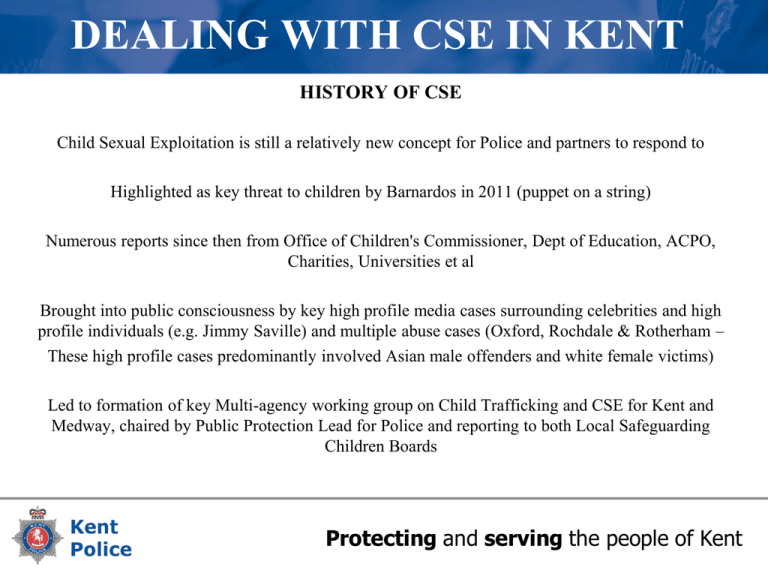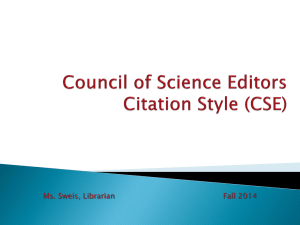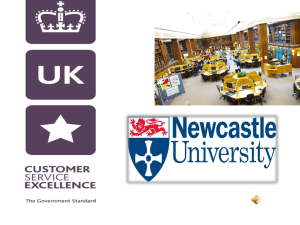
DEALING WITH CSE IN KENT
HISTORY OF CSE
Child Sexual Exploitation is still a relatively new concept for Police and partners to respond to
Highlighted as key threat to children by Barnardos in 2011 (puppet on a string)
Numerous reports since then from Office of Children's Commissioner, Dept of Education, ACPO,
Charities, Universities et al
Brought into public consciousness by key high profile media cases surrounding celebrities and high
profile individuals (e.g. Jimmy Saville) and multiple abuse cases (Oxford, Rochdale & Rotherham –
These high profile cases predominantly involved Asian male offenders and white female victims)
Led to formation of key Multi-agency working group on Child Trafficking and CSE for Kent and
Medway, chaired by Public Protection Lead for Police and reporting to both Local Safeguarding
Children Boards
Protecting and serving the people of Kent
DEALING WITH CSE IN KENT
DEFINITION OF CSE (ACPO)
Sexual exploitation of children and young people under 18 involves exploitative situations, contexts and
relationships where the young person (or third person/s) receive ‘something’ (e.g. food,
accommodation, drugs, alcohol, cigarettes, affection, gifts, money) as a result of them performing,
and/or others performing on them, sexual activities.
Child sexual exploitation can occur through the use of technology without the child’s immediate
recognition; for example being persuaded to post images on the internet/mobile phones without
immediate payment or gain.
Violence, coercion and intimidation are common. Involvement in exploitative relationships is
characterised by the child’s or young person’s limited availability of choice, as a result of their social,
economic or emotional vulnerability.
A common feature of CSE is that the child or young person does not recognise the coercive nature of
the relationship and does not see themselves as a victim of exploitation.
Not a defined crime in its own right
Protecting and serving the people of Kent
DEALING WITH CSE IN KENT
TYPES OF CSE (ACPO)
Inappropriate relationships (teacher-pupil)
Boyfriend (usually lot older – controlling)
Peer on Peer (pressure from friends)
Gang associated (Initiations, control of members, revenge)
Organised Crime Groups (use of children as commodity)
Protecting and serving the people of Kent
DEALING WITH CSE IN KENT
OFFENCES SPECIFIC TO CSE –
SEXUAL OFFENCES ACT 2003
Arranging or facilitating child sex offence
Meeting a child following grooming
Paying for sexual services of child
Causing, inciting, arranging or facilitating child
prostitution/pornography
Trafficking children for sexual exploitation
(other offences – rape, sexual assaults, child abuse image offences)
Protecting and serving the people of Kent
DEALING WITH CSE IN KENT
WORK TO DATE
1) The CT and CSE subgroup have produced clear protocols, procedures and risk assessments for
professionals in Kent and Medway
“Commitment to respond to CSE and trafficking concerns across all partner agencies”
“Clear multi-agency procedures and risk assessment tools supported by high quality training with
evidence of take-up by professionals in a range of settings”
“Clear and ‘fit for purpose’ risk assessment tool has been developed for use with individual young
people”
“Models for more strategic risk assessment with key groups and communities have been developed by
police”
(John Harris 2014)
2) Multi-agency training on CSE - spotting the signs is being delivered to frontline professionals
across the safeguarding partnership. Numerous inputs by Police lead to professional forums
“Training programmes are broadening awareness and understanding”
(John Harris 2014)
Protecting and serving the people of Kent
DEALING WITH CSE IN KENT
WORK TO DATE
3) Currently the sub-group are reviewing over 150 recommendations from 14
contemporary reports on CSE (including the Rotherham report)
This review has 'pooled' recommendations into key themes which will form the groups work
plan for the next 12 to 18 months. The key themes are; policy, procedures, awareness raising
for professionals, awareness raising for the public, training, quality assurance
4) Set up of separate working group to respond to children who going missing.
particularly those in care and ensure key links to potential CSE are identified and responded
to
5) Key Multi-Agency recommendations from Rotherham report remitted to respective
Safeguarding Children Boards
e.g. Local Authorities ensuring proper safeguards for children are in place when
issuing/reviewing taxi licenses
Protecting and serving the people of Kent
DEALING WITH CSE IN KENT
POLICE SPECIFIC ACTIVITY
1) Kent Police share all records of missing children with Kent and Medway Social Care teams
Enables cross checking of information, structured follow up interviews with children. This has been in
place for over 12 months in Medway and has shown a reduction in the numbers of children going
missing on repeat occasions and identified children potentially vulnerable to CSE. It has more recently
been introduced Kent wide. Key questions in these follow ups relate to CSE and have helped inform the
intelligence picture regarding CSE.
2) Police Missing Person Liaison Officers are trained to identify and intervene in potential CSE
cases
Children are referred to Public Protection Teams and make Child Protection Referrals to Social Care
where necessary
3) Data collection, Analysis and production of intelligence profiles
Kent Police have been gathering intelligence on potential cases of CSE since the issue was raised
nationally. Since Feb 2013 Kent Police have adopted a clear 'tagging' of CSE related information
(Genesis records, storm, intelligence reports)
Protecting and serving the people of Kent
DEALING WITH CSE IN KENT
POLICE SPECIFIC ACTIVITY
4) Profiling of CSE in Kent and Medway
CSE part of the Force Strategic Assessment. This has provided a clearer picture of CSE in the County
and in particular the threat of CSE committed by Organised Crime Groups and enabled enforcement
activity.
5) Operation Lakeland
One such operation generated from intelligence sharing between Police and KCC Social Care is Op
Lakeland. This investigation identified 45 potential child victims of CSE, resulting in visits to all of
them and other children, with measures taken to protect them. 22 arrests were made for a range of
serious offences relating to CSE, 8 suspects are charged with 33 offences and currently await trial in
January 2015.
6) On-going intelligence development and investigation
Currently a police led multi-agency effort in another part of the County to respond to CSE concerns, coordinated by a local Supt gold commander, with resources from Serious Crime Directorate, Divisions
and Public Protection all working with key partners to identify and protect vulnerable children and
investigate any offences
Protecting and serving the people of Kent
DEALING WITH CSE IN KENT
POLICE SPECIFIC ACTIVITY
7) Self assessment of Police activity to meet recommendations in ACPO tackling CSE Action Plan
Completed in 2013, reviewed annually to ensure Force is fit for purpose. Kent complies with all
requirements in the Action Plan. Evidence of compliance provided to CEOP and Others
8) Police Online Investigation Team (POLIT)
Recognised as one of the leading Forces nationally and internationally for enforcement of online sexual
exploitation of children. One of only 4 Forces in the UK to fully utilise all available tactics. Identify key
online suspects in Kent as well as victims across the globe. Imprisonment of offenders and key covert
work to convict individuals planning to commit serious sexual offences on children in Kent. (Dale
Bollinger case-recent publicity)
9) Sexual Offences Investigation Team (SOIT)
Being formed on 26th November, Local based staff but under Public Protection management, respond to
all reports of rape and serious sexual assault, provides a more specialised response to such crimes and
improve further the identification of potential CSE. Close working relationship with MPLO’s and PPU
Child Abuse Teams.
Protecting and serving the people of Kent
DEALING WITH CSE IN KENT
FINAL COMMENT – INDEPENDENT INSPECTION ON CSE
“Across Kent and Medway good examples of ‘intelligence-led’
analysis being used to pinpoint patterns of activity and networks
linked to CSE, identifying key communities and individual young
people at risk”
(John Harris)
Questions?
Protecting and serving the people of Kent






